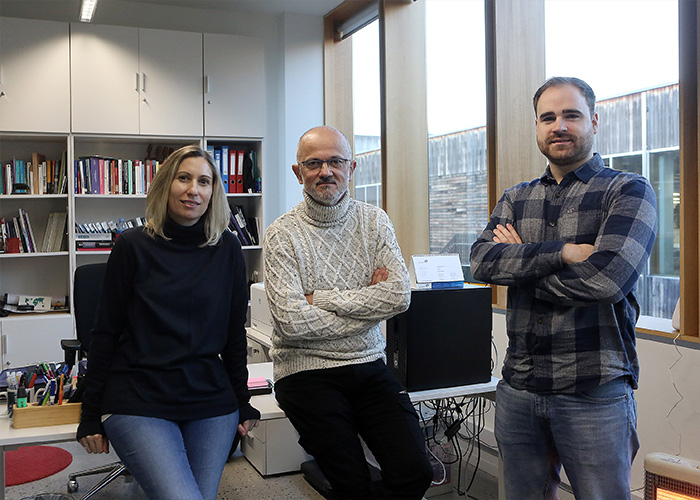The offer of risky leisure opportunities, single-parent families and housing instability are widely recognised in the scientific literature as factors associated with juvenile delinquency. The UPV/EHU’s CRIM-AP research group has studied this link in the crimes committed by youngsters in the BAC (Basque Autonomous Community) to see whether they coincide with other geographical and cultural contexts. They have, however, confirmed that the factors associated with the committing of juvenile crimes would be different ones.
Juvenile delinquency and risky leisure activities, not related in the Basque Country as elsewhere
A study by the UPV/EHU-University of the Basque Country reveals that the factors influencing juvenile delinquency would not act in the same way in all cultural contexts
- Research
First publication date: 08/01/2020

The analysis by the CRIM-AP research group of the Department of Social Psychology and Behavioural Science Methodology at the UPV/EHU’s Faculty of Psychology of nearly 2,000 cases of crimes committed by 12 to 18-year-olds in the BAC has made it possible to explore the situational and contextual factors that accompany juvenile delinquency in our region. “Just like any other behaviour, the committing of crimes also requires that a set of circumstances should come together: the offender and possible victim need to coincide in time and place and, at the same time, there must not be anyone there who could prevent the crime,” explained Alexander Trinidad, the author of the study.
This piece of research set out to cross-check with the BAC context the information available on this subject in the scientific literature and “obtained from studies mostly conducted in Anglo-Saxon and North European countries,” said Trinidad. “According to these sources, one of the factors recurrently linked to juvenile delinquency is that of risky leisure activities understood as those that take place totally unsupervised in which groups of youngsters participate and which are accompanied by the possibility of consuming alcohol or other substances. These activities are frequently associated with the offer of premises such as bars, discos, pubs, etc. so that the more premises of this type there are, the higher the rate of crimes committed by minors in a municipality.”
Although the researchers expected to find the same relationship as that observed in other places, the results of the study conducted did not however reveal the same relationship: “we did not find a significant link between risky leisure opportunity and juvenile delinquency,” as the researcher pointed out. “What this points to is that theoretical models are not universal. That does not mean that new theoretical models need to be developed, but that they need to be adapted to the realities of each geographical and cultural context. On the basis of the fact that between Northern and Southern European countries there is a considerable difference in habits, such as mealtimes, leisure activities and school timetables, it comes as no surprise to find differences, too, in the way in which situational variables affect juvenile delinquency."
What needs to be done, according to Trinidad, is “to look for other variables or to delve further into the characteristics of risky leisure activities among the young people around us. For example, the botellón [when people meet in public spaces, rather than in bars, etc., for the purpose of drinking] is much more widespread in this group than going to bars; also common is meeting in warehouses or premises that the youngsters themselves rent and manage. We would have to look further into what takes places in these leisure locations that are not cited in other geographical contexts”.
Positive relationship between juvenile delinquency and the availability of non-risky leisure activities
In the study they also considered another set of circumstances that could facilitate or encourage the committing of crimes, and they analysed their relationship with crimes already committed. What provided the greatest relationship was “the availability of risk-free leisure, in other words, the number of restaurants, hotels and facilities of that nature”. The study was conducted on a macro level, on a municipal level, and as the researcher explained, “it is not possible to talk about cause and effect, the presence of these places does not cause juvenile delinquency to rise. What it shows is that the municipalities where more facilities of this type exist are more metropolitan enclaves, areas that attract a larger number of people, and bearing in mind that most juvenile crimes are robberies, it may be logical that it is in these place where a greater opportunity to commit them is found”.
Other factors studied and which were seen to be linked to the committing of juvenile crimes was population size, yet no relationship between delinquency and the number of single-parent families nor housing instability (the inhabitants of a municipality moving both within the same locality and that which takes place to and from other municipalities) were confirmed, whereas in other contexts these factors have been shown to have a link.
The expert in juvenile delinquency believes that these results “could be used by the local administrations to deploy measures to prevent crimes in the areas where there is a greater prevalence of them. Finding out about the situational and contextual factors may always be of help; at the end of the day it is about furthering the aetiology of criminal behaviour and conducting a comprehensive analysis of the case studies that will allow effective, evidence-based prevention strategies to be designed”.
Bibliographic reference
- “Jumping at the opportunity”: The role of situational and opportunity factors in juvenile delinquency in Southern Europe
- International Journal of Law, Crime and Justice (2019)
- DOI: 10.1016/j.ijlcj.2019.100347


